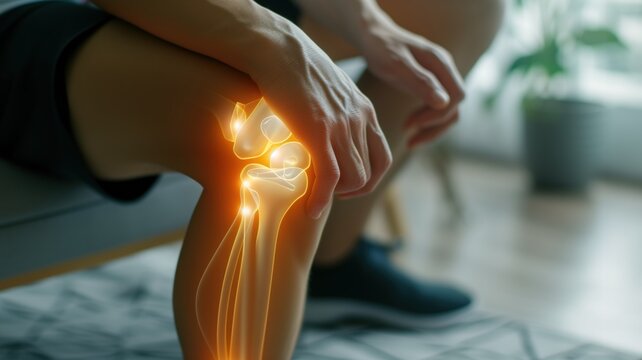A lateral meniscal tear is an injury affecting the lateral meniscus, which is the crescent-shaped cartilage on the outer side of the knee joint. This cartilage acts as a shock absorber, distributing weight evenly across the knee and aiding in smooth movement. When the lateral meniscus is torn, it can lead to pain, swelling, and decreased knee function.
Understanding Lateral Meniscal Tears
The meniscus consists of two pieces of cartilage: the medial meniscus (inner side) and the lateral meniscus (outer side). Both menisci play a crucial role in stabilizing the knee, absorbing shock, and facilitating smooth motion. A lateral meniscal tear occurs when the cartilage on the outer side of the knee is damaged, which can happen due to acute injury or degenerative changes.
Causes and Risk Factors
Lateral meniscal tears can occur due to various reasons:
- Acute Injury: Sudden, forceful movements such as twisting or pivoting on a bent knee can cause a tear. This is common in sports that involve rapid direction changes, such as soccer, basketball, or football.
- Degenerative Changes: Over time, the meniscus can weaken and become more susceptible to tears, especially in older adults or those with long-standing knee issues.
- Combined Injuries: Often, meniscal tears occur in conjunction with other knee injuries, such as ligament tears (e.g., anterior cruciate ligament (ACL) injuries) or cartilage damage.
Symptoms of Lateral Meniscal Tears
The symptoms of a lateral meniscal tear can vary based on the tear’s severity and location:
- Pain: Pain is usually felt on the outer side of the knee and may be sharp or aching. It often worsens with activity and improves with rest.
- Swelling: The knee may swell, especially within the first 24-48 hours after the injury.
- Stiffness: The knee may feel stiff or difficult to fully bend or straighten.
- Locking or Catching: Some individuals experience a sensation of the knee “locking” or “catching,” where the knee may feel stuck or difficult to move.
- Instability: The knee might feel weak or unstable, particularly during weight-bearing activities.
How Physiotherapy Can Help
Physiotherapy is a key component of managing and rehabilitating a lateral meniscal tear. A tailored physiotherapy program can help alleviate pain, restore function, and strengthen the knee to support long-term recovery. Here’s how physiotherapy can assist:
1. Pain and Swelling Management
The initial goal in managing a lateral meniscal tear is to reduce pain and swelling. Physiotherapists employ various methods to achieve this:
- Rest and Activity Modification: Avoiding activities that exacerbate pain and modifying movements to protect the knee.
- Ice Therapy: Applying ice to the knee helps reduce inflammation and numb pain, especially during the first 48 hours post-injury.
- Elevation and Compression: Elevating the leg and using a compression bandage can help control swelling and discomfort.
- Pain Relief Modalities: Techniques such as TENS (Transcutaneous Electrical Nerve Stimulation) and ultrasound therapy may be used to relieve pain and support healing.
2. Restoring Range of Motion
Maintaining and improving the knee’s range of motion is essential to prevent stiffness and ensure the joint can move freely. Physiotherapists guide patients through specific exercises designed to restore flexibility and mobility:
- Gentle Range of Motion Exercises: Exercises like heel slides and knee bends help gradually restore movement without stressing the knee.
- Stretching Exercises: Stretching the quadriceps, hamstrings, and calf muscles can improve flexibility and reduce tension around the knee.
3. Strengthening Exercises
Building strength in the muscles surrounding the knee is crucial for stabilizing the joint and reducing stress on the meniscus. A physiotherapy program includes exercises to strengthen key muscle groups:
- Quadriceps Strengthening: Exercises such as straight leg raises, mini squats, and leg presses target the quadriceps to support the knee.
- Hamstring Strengthening: Hamstring exercises like bridges and hamstring curls help balance the forces around the knee.
- Hip and Core Strengthening: Strengthening the hip and core muscles supports proper alignment and movement patterns, reducing strain on the knee joint.
4. Improving Balance and Proprioception
Lateral meniscal tears can affect balance and proprioception (the ability to sense joint position). Physiotherapy includes exercises to enhance balance and coordination:
- Balance Exercises: Activities like standing on one leg, using a balance board, or performing stability drills improve knee stability and prevent falls.
- Proprioceptive Training: Exercises that challenge the body’s sense of joint position, such as using a wobble board or performing dynamic movements, enhance joint control.
5. Gait Training and Functional Exercises
Improving walking patterns and functional movements is crucial for recovery and preventing re-injury. Physiotherapists assess and retrain gait to ensure proper movement mechanics:
- Gait Analysis: Evaluating walking patterns to identify and correct abnormalities that may contribute to pain or instability.
- Functional Exercises: Practicing movements that mimic daily activities, such as climbing stairs or getting up from a chair, helps ensure the knee can perform these tasks without discomfort.
6. Education and Injury Prevention
Education is a key part of physiotherapy for managing and preventing further injury:
- Activity Modification: Guidance on how to modify or avoid activities that stress the knee joint to prevent exacerbating the injury.
- Footwear Advice: Recommendations for appropriate footwear or orthotics to support proper alignment and reduce knee stress.
- Home Exercise Program: A personalized exercise plan to continue strengthening and maintaining knee function outside of physiotherapy sessions.
Conclusion
A lateral meniscal tear can have a significant impact on your daily life and physical activities. However, with the right approach, recovery is achievable. Physiotherapy offers a comprehensive treatment plan that addresses pain, improves knee function, and supports overall recovery. By working with a physiotherapist, you can develop a personalized program to manage symptoms, restore mobility, and strengthen the knee, ultimately helping you return to your normal activities with greater ease and confidence. If you suspect you have a lateral meniscal tear, seeking early intervention from a physiotherapist can be crucial for achieving a successful recovery and preventing future issues.


